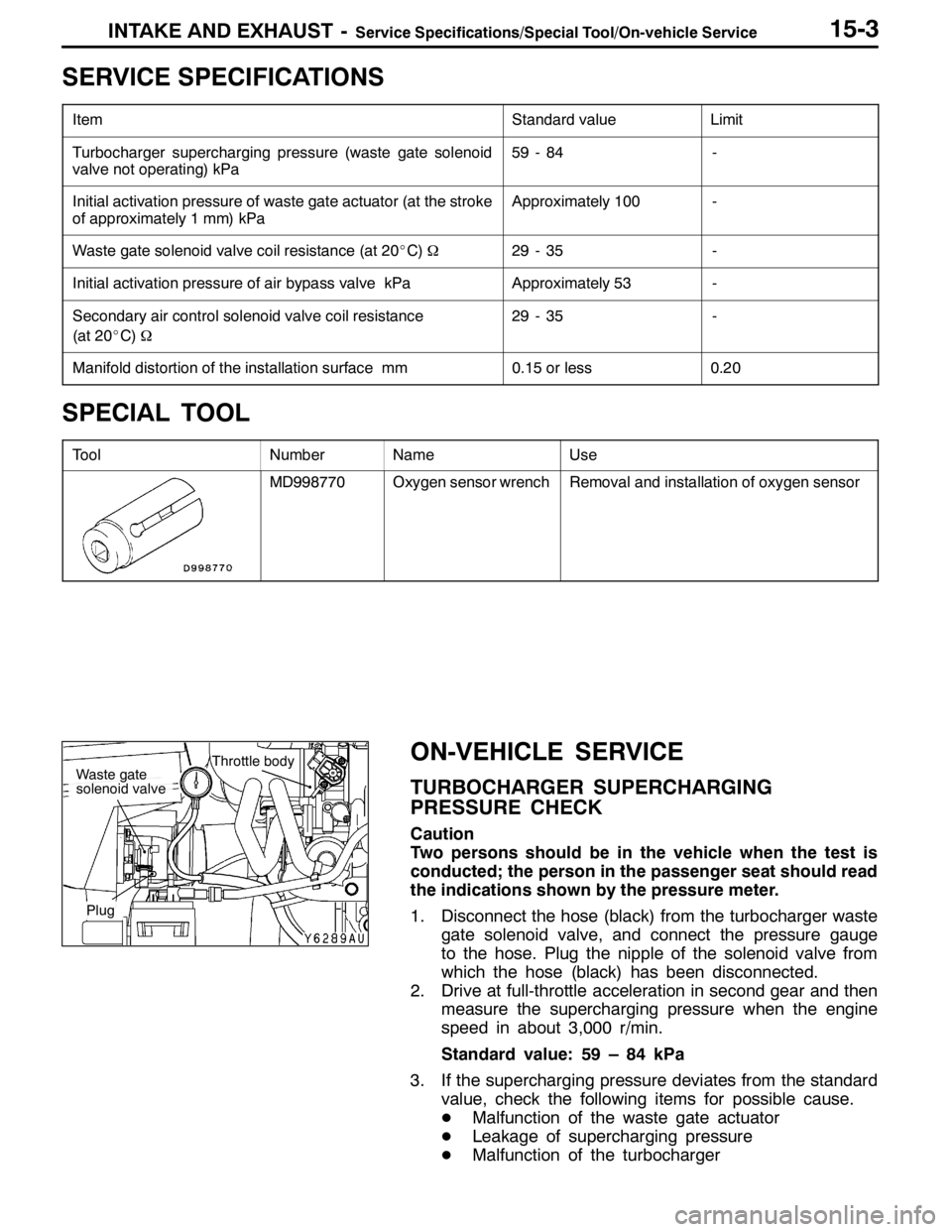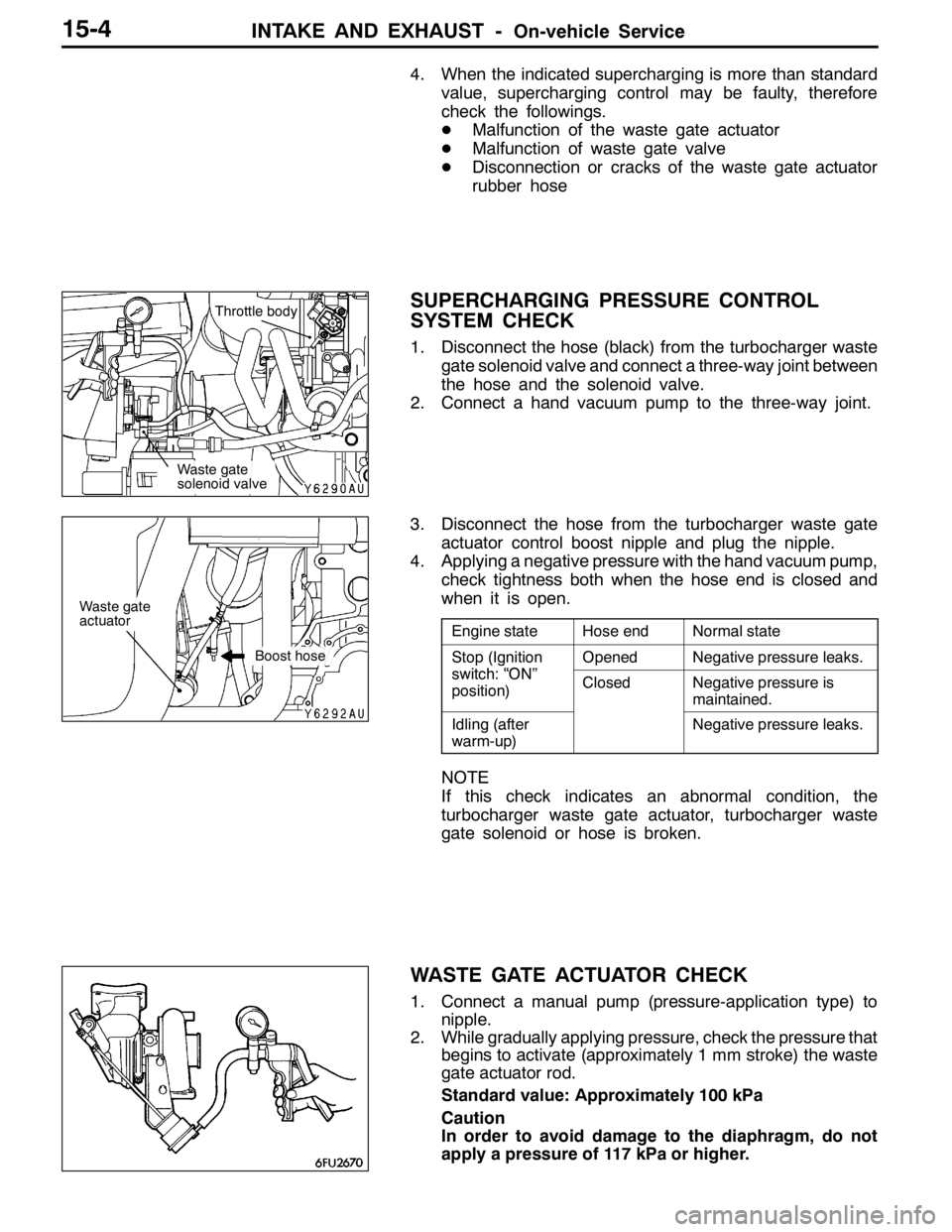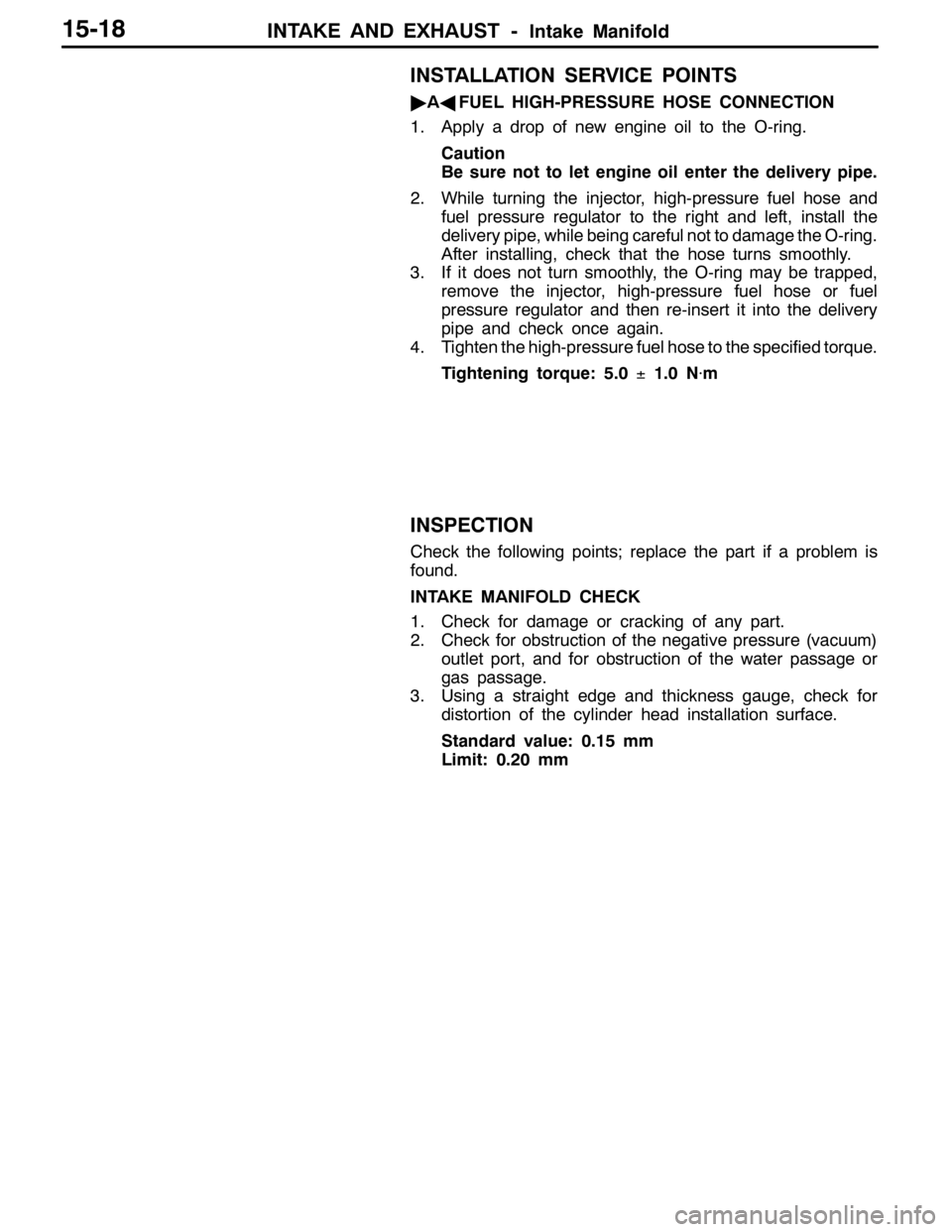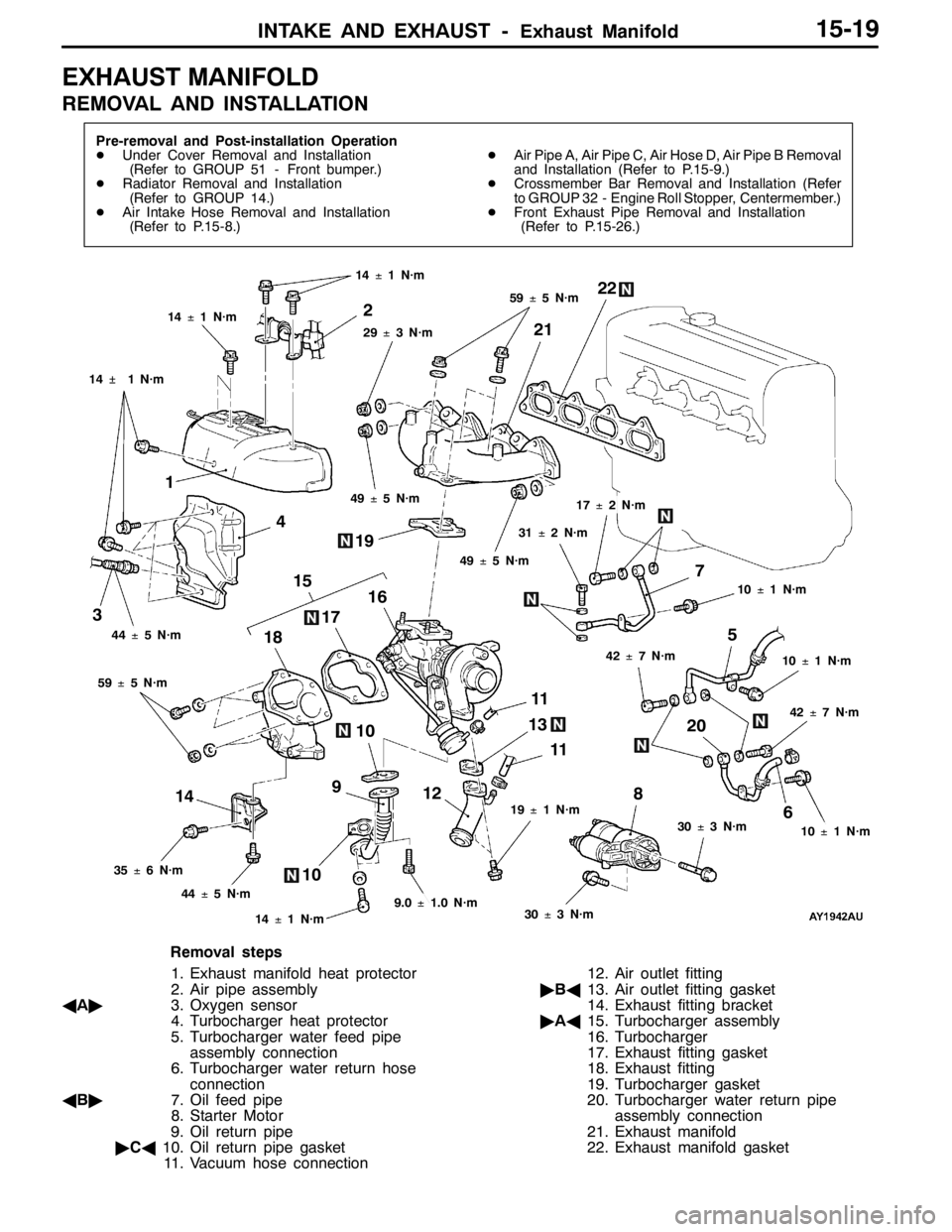Page 709 of 1449

INTAKE AND EXHAUST -Service Specifications/Special Tool/On-vehicle Service15-3
SERVICE SPECIFICATIONS
ItemStandard valueLimit
Turbocharger supercharging pressure (waste gate solenoid
valve not operating) kPa59 - 84-
Initial activation pressure of waste gate actuator (at the stroke
of approximately 1 mm) kPaApproximately 100-
Waste gate solenoid valve coil resistance (at 20_C)Ω29 - 35-
Initial activation pressure of air bypass valve kPaApproximately 53-
Secondary air control solenoid valve coil resistance
(at 20_C)Ω29 - 35-
Manifold distortion of the installation surface mm0.15 or less0.20
SPECIAL TOOL
ToolNumberNameUse
MD998770Oxygen sensor wrenchRemoval and installation of oxygen sensor
ON-VEHICLE SERVICE
TURBOCHARGER SUPERCHARGING
PRESSURE CHECK
Caution
Two persons should be in the vehicle when the test is
conducted; the person in the passenger seat should read
the indications shown by the pressure meter.
1. Disconnect the hose (black) from the turbocharger waste
gate solenoid valve, and connect the pressure gauge
to the hose. Plug the nipple of the solenoid valve from
which the hose (black) has been disconnected.
2. Drive at full-throttle acceleration in second gear and then
measure the supercharging pressure when the engine
speed in about 3,000 r/min.
Standard value: 59 – 84 kPa
3. If the supercharging pressure deviates from the standard
value, check the following items for possible cause.
DMalfunction of the waste gate actuator
DLeakage of supercharging pressure
DMalfunction of the turbocharger
Throttle bodyWaste gate
solenoid valve
Plug
Page 710 of 1449

INTAKE AND EXHAUST -On-vehicle Service15-4
4. When the indicated supercharging is more than standard
value, supercharging control may be faulty, therefore
check the followings.
DMalfunction of the waste gate actuator
DMalfunction of waste gate valve
DDisconnection or cracks of the waste gate actuator
rubber hose
SUPERCHARGING PRESSURE CONTROL
SYSTEM CHECK
1. Disconnect the hose (black) from the turbocharger waste
gate solenoid valve and connect a three-way joint between
the hose and the solenoid valve.
2. Connect a hand vacuum pump to the three-way joint.
3. Disconnect the hose from the turbocharger waste gate
actuator control boost nipple and plug the nipple.
4. Applying a negative pressure with the hand vacuum pump,
check tightness both when the hose end is closed and
when it is open.
Engine stateHose endNormal state
Stop (Ignition
it h“ON”
OpenedNegative pressure leaks.p(g
switch: “ON”
position)ClosedNegative pressure is
maintained.
Idling (after
warm-up)Negative pressure leaks.
NOTE
If this check indicates an abnormal condition, the
turbocharger waste gate actuator, turbocharger waste
gate solenoid or hose is broken.
WASTE GATE ACTUATOR CHECK
1. Connect a manual pump (pressure-application type) to
nipple.
2. While gradually applying pressure, check the pressure that
begins to activate (approximately 1 mm stroke) the waste
gate actuator rod.
Standard value: Approximately 100 kPa
Caution
In order to avoid damage to the diaphragm, do not
apply a pressure of 117 kPa or higher.
Waste gate
solenoid valveThrottle body
Waste gate
actuator
Boost hose
Page 712 of 1449

INTAKE AND EXHAUST -On-vehicle Service15-6
INTAKE MANIFOLD PRESSURE CHECK
Refer to GROUP 11A – On-vehicle Service.
SECONDARY AIR CONTROL SYSTEM CHECK
1. Start the engine and carry out idling.
2. Confirm that the secondary air valve lifts up when the
engine-ECU connector No. 53 terminal is short-circuited
with the earth using a jumper wire.
The engine-ECU connector must be connected at this
time.
SECONDARY AIR CONTROL SOLENOID
VALVE CHECK
OPERATION CHECK
1. Disconnect the vacuum hose (white-striped, yellow-
striped) from the solenoid valve.
2. Separate the harness connector.
3. Connect the hand vacuum pump to the solenoid valve’s
A nipple.
4. Connect the solenoid valve terminal and battery terminal
with a jumper wire.
5. Disconnect the jumper wire between the battery’s ( - )
terminals, apply a negative pressure, and inspect the
tightness.
Jumper wireState of B
nippleNormal state
ConnectedOpenedNegative pressure leaks.
ClosedNegative pressure is
maintained.
DisconnectedClosedNegative pressure leaks.
Vacuum tank
Secondary
air control
solenoid
valve
Battery A B
Page 720 of 1449
INTAKE AND EXHAUST -Secondary Air Supply System15-14
SECONDARY AIR SUPPLY SYSTEM
REMOVAL AND INSTALLATION
Pre-removal and Post-installation Operation
DAir Duct Removal and Installation (Refer to P.15-8.)
DStrut Tower Bar Removal and Installation (Refer to GROUP 42.)
1
2 34
5
49±5 N·m14±1 N·m 22±4 N·m
14±1 N·m 14±1 N·m 20±2 N·m
6
8 9 10
22±4 N·m24±3 N·m23±4 N·m
11±1 N·m Air pipe C 5.9±1.0 N·m
7
7 11
Removal steps
1. Control harness connector
connection
2. Heat protector
3. Vacuum hose connection
DAir pipe C (Refer to P.15-9.)
4. Vacuum pipe
5. Secondary air hose6. Secondary air pipe assembly
"AA7. Gasket
"BA8. Gasket
9. Secondary air control valve
10. Engine hanger
11. Secondary air control valve bracket
Page 722 of 1449

INTAKE AND EXHAUST -Intake Manifold15-16
INTAKE MANIFOLD
REMOVAL AND INSTALLATION
Pre-removal and Post-installation Operation
DAir Duct Removal and Installation (Refer to P.15-8.)
DStrut Tower Bar Removal and Installation
(Refer to GROUP 42.)
DUnder Cover Removal and Installation
(Refer to GROUP 51 - Front Bumper.)
DEngine Coolant Draining and Supplying
(Refer to GROUP 14 - On-vehicle Service.)
DThrottle Body Removal and Installation (Refer to
GROUP 13A - Throttle Body.)DCrossmember Bar Removal and Installation (Refer
to GROUP 32 - Engine Roll Stopper, Centermember.)
DFront Exhaust Pipe Removal and Installation (Refer
to GROUP 15 - Exhaust Pipe and Main Muffler.)
DSecondary Air Control Valve Bracket Removal and
Installation (Refer to P.15-14.)
DEngine Oil Draining and Supplying
1
2
3 4
5 6 7
8 10
11
1214
13
15
16 17
18
9
11±1 N·m3.0±0.5 N·m
13±1 N·m
(Engine oil)
(Engine oil) 5.0±1.0 N·m
14 8
Removal steps
1. Center cover
2. Oxygen sensor connector
connection
3. Injector connector connection
4. Fuel pressure solenoid valve
connector connection
5. Purge control solenoid valve
connector connection
6. Knock sensor connector connection
7. Vacuum hose connection
8. Vacuum hose
9. Fuel return hose connection"AA10. Fuel high-pressure hose connection
11. O-ring
AA"12. Delivery pipe, Injector and fuel
pressure regulator assembly
13. Insulator
14. Insulator
15. Oil level gauge and guide
16. O-ring
17. Brake booster vacuum hose
connection
18. Purge hose connection
Page 724 of 1449

INTAKE AND EXHAUST -Intake Manifold15-18
INSTALLATION SERVICE POINTS
"AAFUEL HIGH-PRESSURE HOSE CONNECTION
1. Apply a drop of new engine oil to the O-ring.
Caution
Be sure not to let engine oil enter the delivery pipe.
2. While turning the injector, high-pressure fuel hose and
fuel pressure regulator to the right and left, install the
delivery pipe, while being careful not to damage the O-ring.
After installing, check that the hose turns smoothly.
3. If it does not turn smoothly, the O-ring may be trapped,
remove the injector, high-pressure fuel hose or fuel
pressure regulator and then re-insert it into the delivery
pipe and check once again.
4. Tighten the high-pressure fuel hose to the specified torque.
Tightening torque: 5.0±1.0 N⋅m
INSPECTION
Check the following points; replace the part if a problem is
found.
INTAKE MANIFOLD CHECK
1. Check for damage or cracking of any part.
2. Check for obstruction of the negative pressure (vacuum)
outlet port, and for obstruction of the water passage or
gas passage.
3. Using a straight edge and thickness gauge, check for
distortion of the cylinder head installation surface.
Standard value: 0.15 mm
Limit: 0.20 mm
Page 725 of 1449

INTAKE AND EXHAUST -Exhaust Manifold15-19
EXHAUST MANIFOLD
REMOVAL AND INSTALLATION
Pre-removal and Post-installation Operation
DUnder Cover Removal and Installation
(Refer to GROUP 51 - Front bumper.)
DRadiator Removal and Installation
(Refer to GROUP 14.)
DAir Intake Hose Removal and Installation
(Refer to P.15-8.)DAir Pipe A, Air Pipe C, Air Hose D, Air Pipe B Removal
and Installation (Refer to P.15-9.)
DCrossmember Bar Removal and Installation (Refer
to GROUP 32 - Engine Roll Stopper, Centermember.)
DFront Exhaust Pipe Removal and Installation
(Refer to P.15-26.)
13 12
3
6 5
8
9
11 192122
14�¶1 N·m
4
7
11
12 15
16
17
18
20
1010
14
14±1 N·m
14±1 N·m
29±3 N·m
59±5 N·m
49±5 N·m
44±5 N·m
59±5 N·m
35±6 N·m
44±5 N·m
14±1 N·m9.0±1.0 N·m30±3 N·m
30±3 N·m10±1 N·m
42±7 N·m
10±1 N·m
10±1 N·m
17±2 N·m
31±2 N·m
49±5 N·m
42±7 N·m
19±1 N·m
Removal steps
1. Exhaust manifold heat protector
2. Air pipe assembly
AA"3. Oxygen sensor
4. Turbocharger heat protector
5. Turbocharger water feed pipe
assembly connection
6. Turbocharger water return hose
connection
AB"7. Oil feed pipe
8. Starter Motor
9. Oil return pipe
"CA10. Oil return pipe gasket
11. Vacuum hose connection12. Air outlet fitting
"BA13. Air outlet fitting gasket
14. Exhaust fitting bracket
"AA15. Turbocharger assembly
16. Turbocharger
17. Exhaust fitting gasket
18. Exhaust fitting
19. Turbocharger gasket
20. Turbocharger water return pipe
assembly connection
21. Exhaust manifold
22. Exhaust manifold gasket
Page 726 of 1449
INTAKE AND EXHAUST -Exhaust ManifoldINTAKE AND EXHAUST -Exhaust Manifold15-20
REMOVAL SERVICE POINT
AA"OXYGEN SENSOR REMOVAL
Use special tool to remove the oxygen sensor.
AB"OIL FEED PIPE REMOVAL
Take care not to let foreign objects get into the oil passage
hole of the turbocharger after the oil feed pipe is removed.
INSTALLATION SERVICE POINT
"AATURBOCHARGER INSTALLATION
1. Clean the oil feed pipe, oil return pipe, water pipe fitting,
the inside of eye bolt, and individual pipe for clogs.
2. Clean or blow the air if carbon particles are stuck to the
oil passage of the turbocharger.
Caution
Take care not to let foreign objects get into the
turbocharger.
3. Refill new engine oil at the oil feed pipe fitting hole of
the turbocharger.
"BAAIR OUTLET FITTING GASKET INSTALLATION
Install the gasket so that its protrusion can face towards the
direction as shown in the illustration.
MD998770
Oxygen sensor
View A
View A
TurbochargerProtrusion